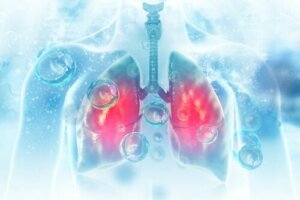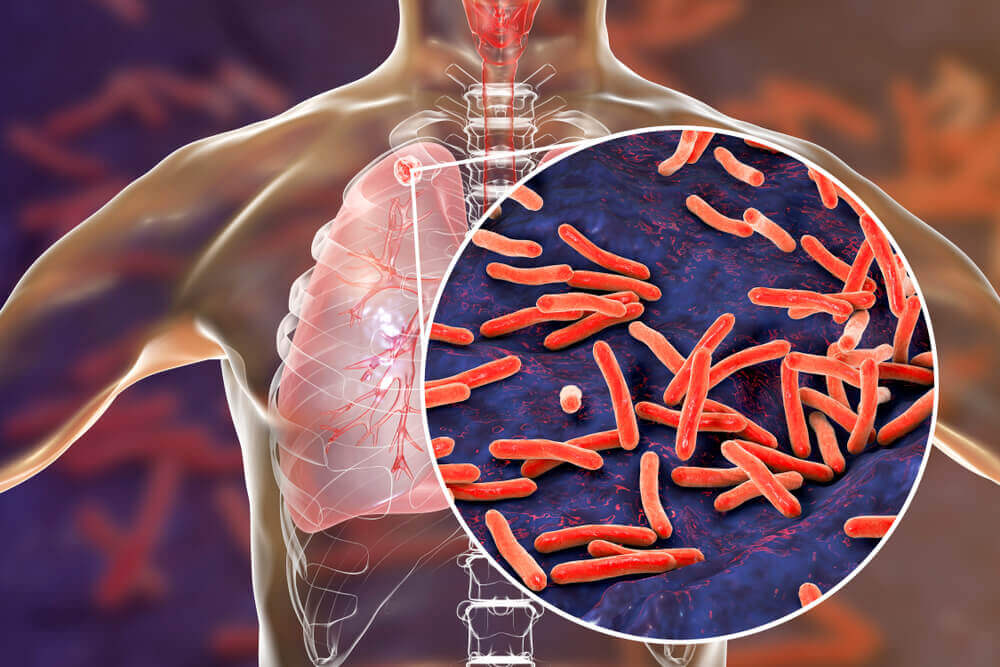What Is Pneumonia?

Pneumonia is an acute infectious process of the lungs. This disease is characterized by the presence of fever, cough, and chest pain, along with lung abnormalities visible on a chest x-ray.
For many doctors, it can be a real challenge. Establishing the diagnosis and carrying out an appropriate treatment isn’t as easy as people think. This is because, sometimes, it doesn’t have the usual symptoms.
Next up, we’ll tell you all about this illness, its characteristics, symptoms, and some of its causes.
Who can get it?
The appearance of this disease depends on the interaction between various factors such as underlying diseases, the immune-nutritional status, and the environment. Age has been shown not to be as significant once these factors have been corrected. The problem is that these factors accumulate as the years go by, increasing the risk of suffering from it.
Pneumonia develops in patients with risk factors, such as those with:
- Presence of dysphagia or difficulty swallowing
- Basic neurological disease
- Functional impairment, due to muscular or neurological diseases
- Urinary incontinence
- Malnutrition
In community studies in the United States and Finland, it was found that there’s an annual incidence of pneumonia of between 34 and 40 cases per 1,000 children under 5 years of age, higher than in any other age group, except the elderly over 75 years.
How is pneumonia classified?
We can classify pneumonia into three types:
- Typical pneumonia, produced by bacteria
- Atypical, or produced by atypical viruses or bacteria.
- Not classifiable, it doesn’t meet criteria that allow it to be included in either of the two previous groups.

In most cases, it’s difficult to distinguish the types of pneumonia. Because of this, criteria and algorithms have been established that combine clinical, analytical, and radiological criteria. According to these calculations, you can include pneumonia within one of the three groups.
Most frequent symptoms
Depending on the type of agent causing the disease, different clinical pictures can be found that often help to differentiate between one type of pneumonia and another.
Typical pneumonia
This is characterized by a high fever with chills and generally feeling bad. On some occasions, the appearance of cold sores can be observed.
It’s typical to find chest pain and purulent expectoration, which can be yellow or greenish-yellow in color. Most patients sometimes report difficulty breathing with minimal effort. When listening to the chest, it’s typical to find abnormal sounds such as crackles or rhonchi.
However, this form of presentation is found especially in adults. It can occur in children, but it’s very rare in infants.
Atypical pneumonia
This is characterized by starting with mild fever, dry cough, and shortness of breath. At the time of auscultation, asthma-like aggregates are usually heard.
Viral pneumonia
This is accompanied by flu-like symptoms with a slight increase in body temperature (between 38.3°C and 39°C) or moderate fever, accompanied by:
- Pharyngitis
- Coryza
- Conjunctivitis
- Extrapulmonary symptoms, such as a skin rash or diarrhea

Atypical bacterial pneumonia
It may be accompanied by a headache, muscle pain, and characteristically an irritating dry cough. Sometimes, extra-respiratory symptoms can be associated, such as:
- Encephalitis
- Guillain-Barré syndrome
- Neuritis
- Hemolytic anemia
- Myocarditis
- Erythema multiforme exudative
Diagnosis of pneumonia
To be able to diagnose pneumonia effectively, and early on, the study of the patient’s symptoms must be combined with various available diagnostic methods:
Clinical manifestations
When observing the patient, we must pay attention to the presence of the symptoms that have already been mentioned. Through these, the presence of a respiratory infection can be suspected.
Analytical studies
It should be noted that this isolated test isn’t helpful in diagnosing the disease. However, a complete blood count can generally be used, as it can guide the treating physician to the possible cause of pneumonia.
- Leukocytosis or elevation of the white count
- Deviation to the left, due to an increase in segmented or neutrophils
- Gram stain
- Recent sputum culture or bronchial aspirate, less than 30
minutes> 25 polymorphonuclear leukocytes / field
Imaging studies
Images suggestive of respiratory infection can be observed, such as:
- Condensations in one or more lung lobes
- The presence of pleural effusion – although its absence doesn’t rule out bacterial infection.
- Diffuse interstitial infiltrates are frequently associated with viral infections.
Microbiological studies
These studies make it possible to establish the etiological diagnosis of pneumonia. However, this is often difficult and complex, especially in the case of bacterial pathogens causing atypical pneumonia.
Treatment
Treatment of pneumonia is generally empirical, especially in the early stages of the disease. This is based on:
- The age of the patient, due to the close relationship between age and the etiology of pneumonia
- Characteristics of the disease
- Bacterial resistance in the environment of the patient
Treatment is based on antibiotics, expectorants and steroids with bronchodilator action. Remember that you should never self-medicate, and, in the event of any illness or symptom, you should go to your treating doctor.
Pneumonia is an acute infectious process of the lungs. This disease is characterized by the presence of fever, cough, and chest pain, along with lung abnormalities visible on a chest x-ray.
For many doctors, it can be a real challenge. Establishing the diagnosis and carrying out an appropriate treatment isn’t as easy as people think. This is because, sometimes, it doesn’t have the usual symptoms.
Next up, we’ll tell you all about this illness, its characteristics, symptoms, and some of its causes.
Who can get it?
The appearance of this disease depends on the interaction between various factors such as underlying diseases, the immune-nutritional status, and the environment. Age has been shown not to be as significant once these factors have been corrected. The problem is that these factors accumulate as the years go by, increasing the risk of suffering from it.
Pneumonia develops in patients with risk factors, such as those with:
- Presence of dysphagia or difficulty swallowing
- Basic neurological disease
- Functional impairment, due to muscular or neurological diseases
- Urinary incontinence
- Malnutrition
In community studies in the United States and Finland, it was found that there’s an annual incidence of pneumonia of between 34 and 40 cases per 1,000 children under 5 years of age, higher than in any other age group, except the elderly over 75 years.
How is pneumonia classified?
We can classify pneumonia into three types:
- Typical pneumonia, produced by bacteria
- Atypical, or produced by atypical viruses or bacteria.
- Not classifiable, it doesn’t meet criteria that allow it to be included in either of the two previous groups.

In most cases, it’s difficult to distinguish the types of pneumonia. Because of this, criteria and algorithms have been established that combine clinical, analytical, and radiological criteria. According to these calculations, you can include pneumonia within one of the three groups.
Most frequent symptoms
Depending on the type of agent causing the disease, different clinical pictures can be found that often help to differentiate between one type of pneumonia and another.
Typical pneumonia
This is characterized by a high fever with chills and generally feeling bad. On some occasions, the appearance of cold sores can be observed.
It’s typical to find chest pain and purulent expectoration, which can be yellow or greenish-yellow in color. Most patients sometimes report difficulty breathing with minimal effort. When listening to the chest, it’s typical to find abnormal sounds such as crackles or rhonchi.
However, this form of presentation is found especially in adults. It can occur in children, but it’s very rare in infants.
Atypical pneumonia
This is characterized by starting with mild fever, dry cough, and shortness of breath. At the time of auscultation, asthma-like aggregates are usually heard.
Viral pneumonia
This is accompanied by flu-like symptoms with a slight increase in body temperature (between 38.3°C and 39°C) or moderate fever, accompanied by:
- Pharyngitis
- Coryza
- Conjunctivitis
- Extrapulmonary symptoms, such as a skin rash or diarrhea

Atypical bacterial pneumonia
It may be accompanied by a headache, muscle pain, and characteristically an irritating dry cough. Sometimes, extra-respiratory symptoms can be associated, such as:
- Encephalitis
- Guillain-Barré syndrome
- Neuritis
- Hemolytic anemia
- Myocarditis
- Erythema multiforme exudative
Diagnosis of pneumonia
To be able to diagnose pneumonia effectively, and early on, the study of the patient’s symptoms must be combined with various available diagnostic methods:
Clinical manifestations
When observing the patient, we must pay attention to the presence of the symptoms that have already been mentioned. Through these, the presence of a respiratory infection can be suspected.
Analytical studies
It should be noted that this isolated test isn’t helpful in diagnosing the disease. However, a complete blood count can generally be used, as it can guide the treating physician to the possible cause of pneumonia.
- Leukocytosis or elevation of the white count
- Deviation to the left, due to an increase in segmented or neutrophils
- Gram stain
- Recent sputum culture or bronchial aspirate, less than 30
minutes> 25 polymorphonuclear leukocytes / field
Imaging studies
Images suggestive of respiratory infection can be observed, such as:
- Condensations in one or more lung lobes
- The presence of pleural effusion – although its absence doesn’t rule out bacterial infection.
- Diffuse interstitial infiltrates are frequently associated with viral infections.
Microbiological studies
These studies make it possible to establish the etiological diagnosis of pneumonia. However, this is often difficult and complex, especially in the case of bacterial pathogens causing atypical pneumonia.
Treatment
Treatment of pneumonia is generally empirical, especially in the early stages of the disease. This is based on:
- The age of the patient, due to the close relationship between age and the etiology of pneumonia
- Characteristics of the disease
- Bacterial resistance in the environment of the patient
Treatment is based on antibiotics, expectorants and steroids with bronchodilator action. Remember that you should never self-medicate, and, in the event of any illness or symptom, you should go to your treating doctor.
- Howie, S. R. C., Hamer, D. H., & Graham, S. M. (2016). Pneumonia. In International Encyclopedia of Public Health. https://doi.org/10.1016/B978-0-12-803678-5.00334-9
- Resano Barrio, P. (2018). Community-acquired pneumonia. Medicine (Spain). https://doi.org/10.1016/j.med.2018.10.002
- Kolditz, M. (2016). Severe community-acquired pneumonia. Pneumologe. https://doi.org/10.1007/s10405-016-0041-6
- Fernandez, J. F., Chen, B., & Restrepo, M. I. (2011). Complications. In Primary Care Management of Community-Acquired Pneumonia. https://doi.org/10.2217/EBO.11.51
Este texto se ofrece únicamente con propósitos informativos y no reemplaza la consulta con un profesional. Ante dudas, consulta a tu especialista.







